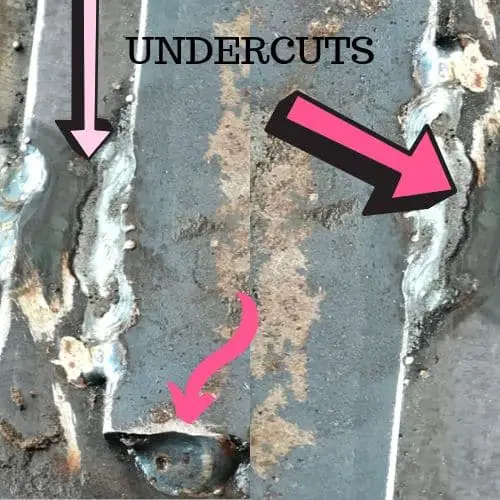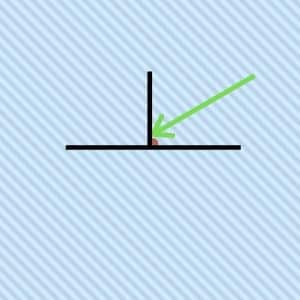
Defects are so common in any kind of manufacturing, including welding. In the process, there might be deviations in the size and shape of the metal structure. It may also be due to the use of improper welding processes or wrong welding techniques. Known as unacceptable weld profiles or defects, these imperfections negatively affect the durability and strength of a weld. One of the more common weld defects in welding is undercut.
Undercut or undercutting is a weld defect that results in the reduction of the thickness of a material that’s being welded. Knowing how to properly identify this defect will enable a welder to take the necessary steps in avoiding it.
Undercut Definition In Welding
Contents
An undercut is a flaw or imperfection that is characterized by a hollow formation on the weld toe due to overheating at the edges of the base metal. This defect usually occurs when you try to make weld with either fast travel speed or high welding current.
What results in undercutting is the failure to get good tie-in with both sides of the base metal. That is because the metal melts much faster at the edges, rather than in the middle.
For instance, on a T-joint, the standing plate is most frequently welded on the edge, where it is more vulnerable to melt-through. Since the bottom plate is welded in the middle, it actually makes sense in focusing more heat on it as it can absorb more. A lot of beginners forget about this basic rule on how metal responds to heat.
Remember, undercut is different from a regular crater in weld –this is just a crack that develops during the solidification process of the welded metals.
Moreover, you might also undercut on the bottom plate when you don’t have enough filler that particular side of the joint. Therefore, aside from focusing more heat on it, make sure that you are pausing on both sides of the bead; so that the weld puddle will cover both the of the edges of the joints. In the case of a T-joint, you actually need to spend more time on the upper side of the joint to form normally shaped bead.
This is an important skill that a welder should master since it’ll happen repeatedly in almost all kinds of welding tasks.

Types Of Undercutting
- Internal Undercutting
Also known as the root undercut, it happens in a butt joint weld alongside the base metal next to the weld’s root. In pipe welding, it’s seen inside the pipe on the narrow edge.
One more form of the internal undercutting can be seen within the weld itself. It can be seen as a groove left on the sidewall. When the ensuing weld bead is put in the weld area, it may form inclusions on the metal. When the undercutting isn’t properly adjusted, it may appear in the x-ray.
- External Undercutting
Also known as the crown undercut –it is a kind of undercut in welding that is apparent on the outside of the weld. It can be seen as a groove or erosion alongside the edge of the weld. This isn’t a good sign in as it will weaken the weld and might make it vulnerable to cracking on the weld edges.
What Causes Undercut In Welding?
Undercut in welding, as what we’ve said is a groove formation at the weld toe, reducing the cross-sectional thickness of the base metal. This often results in weak weld and workpiece. Some of its causes include the following:
- Poor weld technique
- Improper filler metal
- Improper use of gas shielding
- The electrode/filler is too large
- The use of an incorrect angle that may direct more heat to edges
- Too fast travel speed
- Too high weld current
- Loose-fitting in shielding gas channel into the welding gun
- Untidy base metal
- The nozzle is too small
- Contaminated and insufficient shielding gas
Undercut Repair: Ways To Avoid Undercut In MIG Welding
- Proper Welding Position
Sometimes, making a fillet weld in a horizontal-vertical spot also results in undercuts. In this case, there will be a formation of droplets because of the inadequate metal filling on the edges of the joint. To prevent this, you can weld in a flat position to make sure that there is enough electrode consumption.
- Proper Welding Technique
The issue of undercut may also arise when a welder tries making a weld run using an excessive style of weaving. Standards and codes require the suggested width of weaving, according to the size of the electrode. Weaving size must be exceeded to its acceptable limit. If not, the weld might be susceptible to undercut grooves. To prevent this, try to reduce the weaving size or produce the weld in a multi-pass technique.
- Proper Selection Of Gas Shielding
In the case of a metal active gas, improper selection of gas shielding is also one cause of undercutting. Using carbon dioxide with inert gases may provide good results in welding carbon steels.
- Moderate Travel Pace
It is recommended that you travel in a moderate manner. Too slow and too high travel pace will cause issues. For example, if you travel too slow, the bead will be too high, resulting in a weak joint. On the other hand, if you travel too fast you might create undercuts.
- Right Electrode Angle
Welding angles play an important role in the production of defect-free beads. For this, you should use correct angles to direct more heat into thicker components.
- Right Heat Input
The heat or amperage settings are one of the major causes of undercut in welds. To prevent this, you should take care of the weld heat by reducing its current. You can also slightly manipulate the heat input with the stick out of the electrode. The longer the stick out, the less heat it produces.
Also, when welding thin metal and body panels, make sure that the base metals are tightly fitted together. For example, if you are doing lap weld and the base metals are not secured against each other, you will most likely get burn trough and undercut.
- Use Multi-Run Technique
This is one of the best options that you can do to avoid undercut in welding. It supports all of the preventive tips above, as well as help in producing fine welds with enhanced mechanical properties.
Conclusion
Weld flaws like undercut come in all shapes, degrees of severity, and sizes. But one thing is true about them –they are costly, common, and cause a loss in productivity and increase downtime. Good thing is, there are ways on how to avoid undercut in MIG welding. In my opinion, the main remedy for an undercut is lowering the current or amperage. More than likely that will fix the problem.
Bear in mind that even the most skilled welders experience weld flaws like porosity. It is so important to identify and resolve them as soon as possible.
Here you can read more about how a good weld should really look like.
